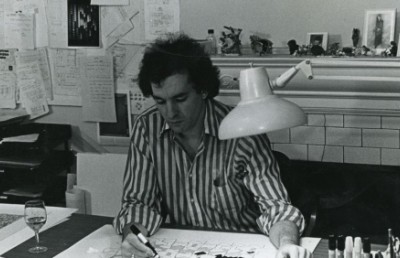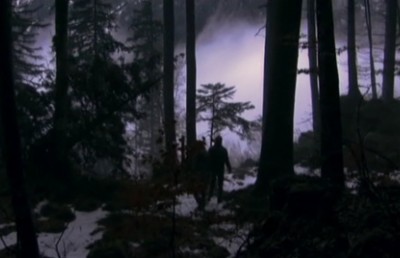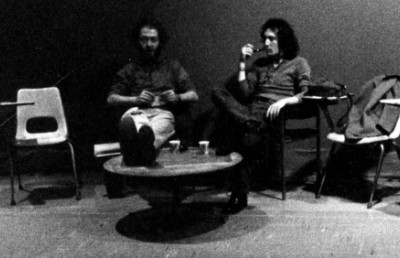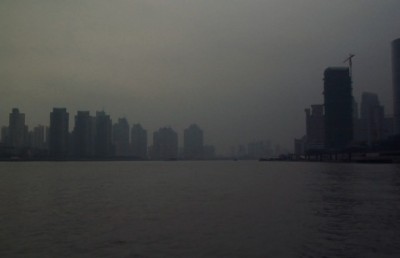TIFF 2015: Some Tentative First Impressions
The Wavelengths Section
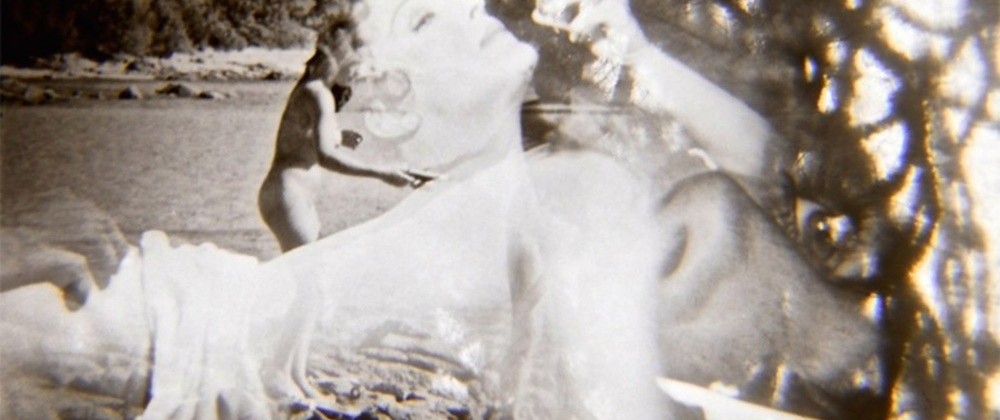
Never having been to the Toronto International Film Festival (TIFF) before, I had perhaps unrealistic expectations for the first program of experimental shorts curated by Andréa Picard as part of the Wavelengths section, which is the big leagues as far as avant-garde cinema is concerned. But while all of the movies in the program were interesting enough, Peter Tscherkassky’s The Exquisite Corpus — which, for better or for worse, was the last screened — was so far ahead of the competition, both in conception and execution, that the preceding shorts seemed diminished in comparison. During the post-screening Q&A, the other filmmakers looked all the more embarrassed standing on stage as Tscherkassky was one of just two artists featured in the program who didn’t attend the screening — the other being Paul Sharits, who had the good excuse of being dead.
As in Outer Space (1999) and Instructions for a Light and Sound Machine (2005), Tscherkassky plunders images from commercial movies, transfers them to black and white, and masks and superimposes them using an optical printer to create a flickering collage that looks like an amped-up version of a German expressionist dream sequence projected on water. Where this film differs most noticeably from Tscherkassky’s earlier work is in his choice of which images to remix; instead of a single mainstream feature, be it a Barbara Hershey horror flick or Sergio Leone western, here he goes to town on several softcore porno movies from the 1970s. The film opens with an Adam and Eve-like couple who live on a tropical island setting sail in search of other swingin’ naturists, but in Tscherkassky’s version of Genesis, it’s lesbian desire that brings about the Fall — i.e., the filmmaker’s manipulations of the images. If this is what sin looks like, I don’t want to be good.
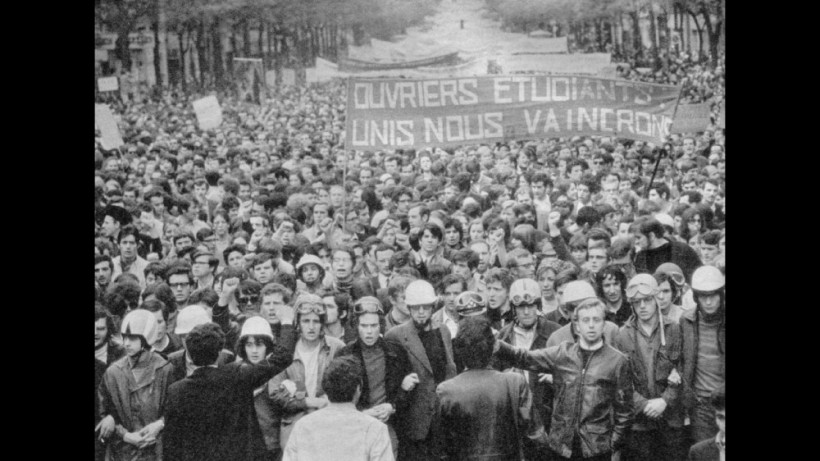
Actua 1
There was no clear standout in the fourth program of Wavelengths shorts, which ran the gamut from political agit-prop to almost pure abstraction. The show opened with Philippe Garrel’s Actua 1, filmed during the events of May ’68 and long thought lost. It consists of a series of images of demonstrators clashing with police that get progressively longer, while in voice-over, a man and a woman offer a lucid commentary on police brutality with stray bits of nonsense thrown in at random, as if to test whether the audience is paying attention. At the opposite end of the spectrum was Daïchi Saïto’s Engram of Returning, in which a black screen is punctuated by streaks and flashes of colour that disappear so quickly one can just barely make out a snow capped mountain or tropical coastline. Set to a relentless, droning jazz score that sounds like the vuvuzela of the apocalypse, it’s pretty intense, but while I admired the film in a way, I have to say I was relieved when it was over.
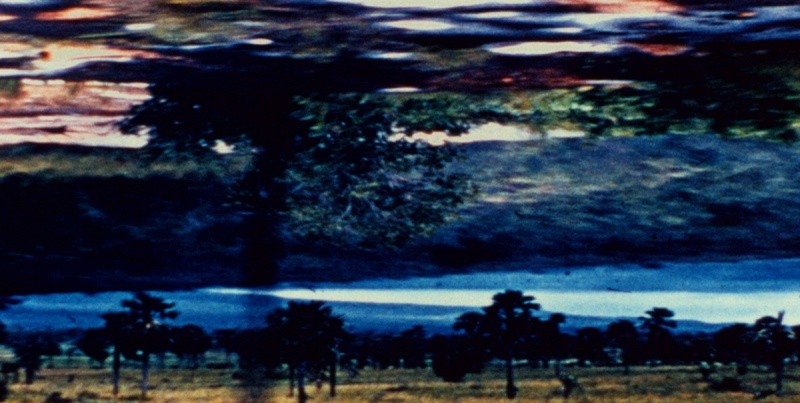
Engram of Returning
Also of interest: Ephraim Asili’s Many Thousands Gone juxtaposes images of black street dancers in Salvador, Brazil with shots of an event commemorating the death of Michael Jackson in Harlem, and is set to a minimalist score that sounds like someone farting really slowly. Samuel M. Delgado and Helena Girón’s Neither God Nor Santa Maria alternates between an audio recording of a group of old men telling tall tales about an alleged witch and hand-processed images of an old woman pottering about in her garden and napping. And William E. Jones’ tragicomic Psychic Driving unearths a 1979 ABC News report about the CIA’s efforts to develop methods of mind control. While Jones leaves the audio as is, the image track moves several times from multicoloured blotches to horizontal lines to legible images and back to blotches as the human toll of the experiments, carried out on unwitting subjects who were supposedly being treated for depression, gradually comes into focus.
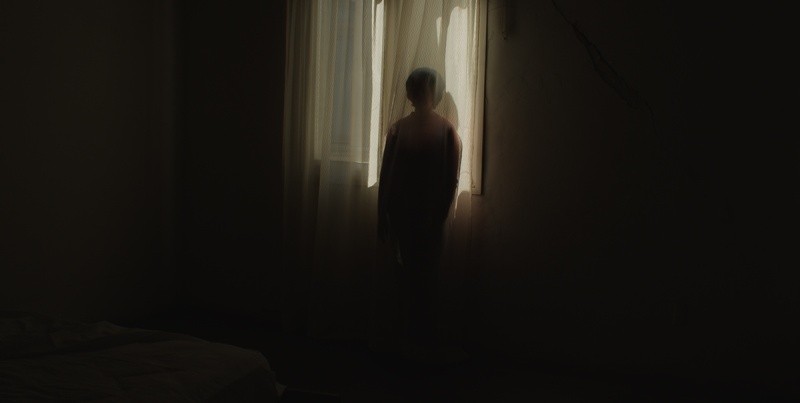
Minotaur
Having only read one or two articles about Nicolás Pereda some years ago, I’d never formed a very definite idea about what kind of filmmaker he was, so for the first third of the first shot of Minotaur, I was wondering why this movie was in the Wavelengths section, as at first glance, it looks like a fairly routine festival film. In an unbroken long take from a fixed camera position, we see a young slacker, Gabino (Gabino Rodríguez), talking to a friend on the phone, giving some money to his maid, and paying a delivery man for pizza. I only started to figure it out when Gabino falls asleep at his desk and literally nothing happens in the frame for, like, a minute until his roommate, Paco (Francisco Barreiro), walks through the door and tries unsuccessfully to wake him. The rest of the movie’s fifty-three minutes consist mainly of the two guys and a young woman (Luisa Pardo) reading aloud from various books and falling asleep in different places in the apartment, often in unusual positions. The lack of exposition and off-kilter ‘Scope framings keep the movie mysterious and intriguing throughout, but I don’t think I’d want to see it again.
It’s easy to see why Picard decided to pair Minotaur with Lois Patiño’s short Night Without Distance as stasis is a common theme in both, the difference being that this movie doesn’t feel at all minimal. Set in a mountain village in Galicia on the border with Portugal, the film consists of a series of static tableaux in which the only motion is supplied by the movement of animals and grass blowing in the wind, and the incremental tracking of the camera from left to right. Patiño shot the movie during the day and inverted the colours in post, giving the images an otherworldly nocturnal quality, and there’s a gradual progression from depopulated landscapes to closer views of the people and back so that a medium shot of a fat guy in a sweater feels like a major event. Eventually something like a plot begins to emerge involving the smuggling of horses into Portugal, but ultimately it proves to be a kind of narrative bubble dance, teasing a development that never materializes.
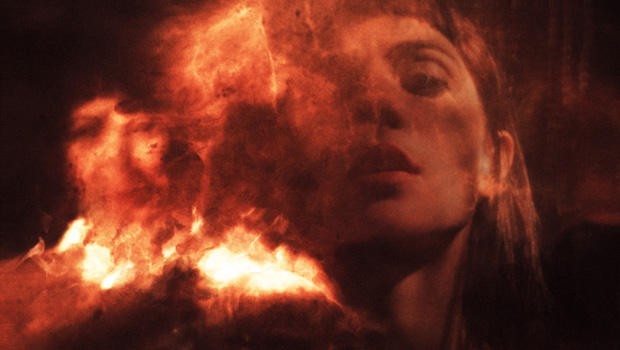
The Forbidden Room
By way of contrast, Guy Maddin and Evan Johnson’s The Forbidden Room is overflowing with stories within stories inside of other stories hiding in a moustache. The film’s method is encapsulated in the opening credits (which go by too fast to read), a spastic collage of titles in a variety of styles reminiscent of movies from different periods and genres. Similarly, the plot combines a submarine thriller with a kammerspiel set in an elevator for some reason, a melodrama about moustaches, an educational film on how to take a bath, and a bunch of other stuff, all of it magnificently silly. Maddin has said in interviews that the various stories were inspired by descriptions of lost movies (which may or may not explain why the characters in one subplot all have Chinese names, even though the actors are white), and the filmmakers use digital technology to make the movie— which was shot on high def video — look like a disintegrating celluloid print.
According to Maddin, there are seventeen stories in total, including “The Book of Climaxes” (a hilarious montage of kisses and explosions that takes the place of a real ending), and part of the fun is how the movie unifies these disparate elements. One obvious method of linking two stories is a flashback, such as the one here that never quite gets around to explaining how a lumberjack suffering from partial amnesia (Roy Dupuis) finds himself aboard a doomed submarine at the bottom of the sea. And while I can’t recall any instances of one character verbally relating a story to another (as in Don Quixote [1605-15]), at one point a farmer reads a newspaper article about a woman injured in a motorcycle accident, which leads into a long narrative involving the woman and her doctors. As this suggests, over the course of the film, the connections between the different stories become increasingly tenuous and the devices linking them more surreal: There’s a story dreamed by a character in someone else’s flashback, a story illustrating a song performed in a nightclub in the dream, and a story whispered by the snow (to name a few). No other movie I sat the festival was as much fun.
*
Having only seen one of Ben Rivers’ films prior to the festival, I didn’t have too firm an idea what to expect from The Sky Trembles and the Earth Is Afraid and the Two Eyes Are Not Brothers. In her introduction to the movie, Picard promised surprises, and the film both was and wasn’t what I was expecting — in that order. The first part of the movie documents a Moroccan film crew at work in the mountains, but it’s not clear what the movie they’re making is about, just as it wasn’t explained in Two Years at Sea (2011) why the film’s subject chose to live in the woods like a hermit. At one point, the director, Oliver Laxe, reads aloud from the Paul Bowles story that gives Rivers’ movie its name (though I couldn’t make out what he was saying due to his accent), and which I gather Laxe’s film is an adaptation of, though not having read any Bowles I can’t be sure. (In the post-screening Q&A, Rivers cited Pere Portabella’s Cuadecuc, vampire [1971] as an influence, the difference being that even people who haven’t read Bram Stoker’s Dracula [1897] are likely to be familiar with its plot.)
Furthermore, the fact that Laxe is a Galician Muslim who lives in Morocco and speaks both Arabic and Berber — making him somewhat less of an outsider than Bowles was — is a nuance that was as lost on me (who mistook him for a local) as it was on another viewer who grilled Rivers after the screening over his portrayal of the Moroccans in the second half of the movie, in which Laxe is kidnapped by bandits who cut out his tongue (I thought it was his ear), dress him in a suit covered with lids from tin cans, and force him to dance. This sudden left turn into outright fiction was certainly a surprise, but as in the first part of the movie, Rivers’ emphasis on process (as opposed to psychology) has the effect of objectifying the characters, especially as Laxe has his faced covered for much of the film. This makes the movie’s brutality easier to take than it would be in a normal character-centred film, but after a while, the plot becomes as monotonous as the incessant clanging of the tin can suit.
*
Sergei Loznitsa’s The Event consists entirely of black and white footage shot by a TV crew in Leningrad during an attempted coup d’état in the summer of 1991, when party hardliners briefly wrested power from the reformists led by Gorbachev and Yeltsin. Edited down to seventy minutes from three hours of material (the only footage of the period that exists on 35mm, as TV stations were ordered not to shoot anything), and divided into several chapters by short stretches of black leader accompanied by music from Swan Lake (1876), the footage shows the spontaneous resistance of the people of Leningrad, who responded to news of the coup by organizing a general strike, erecting barricades in the streets, and gathering in the town square to listen to portable radios and wait for a possible military crackdown.
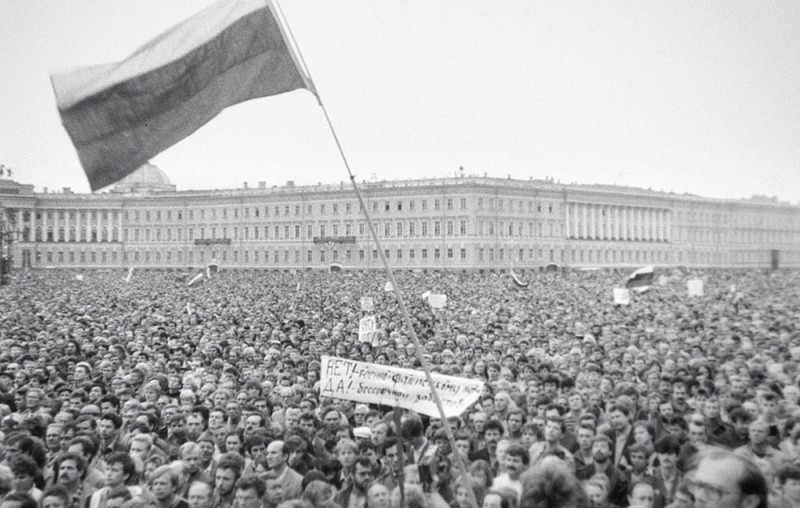
The Event
In lieu of voice-over narration or talking head interviews, the film’s soundtrack is a cacophony of contemporary radio broadcasts, passionate political speeches, and gossip, but while the movie has a certain on the ground immediacy, it’s not nearly as emotional as David France’s How to Survive a Plague (2012) — another recent documentary consisting mainly of archival footage of civil disobedience — as none of the protestors ever emerge as individuals we can care deeply about; instead, they remain an impersonal mass. Also, I didn’t quite understand what was happening in the film’s final sequence, in which some local party officials are arrested for their complicity in the coup, but luckily for me, Loznitsa was at the screening and was gracious enough to explain its significance as political theatre.
*
During the festival, I didn’t stray too far from the Wavelengths section as I assumed I’d be able to catch up with most of the narrative films I wanted to see later, though I did make a point of watching Evolution, Lucile Hadzihalilovic’s belated follow-up to Innocence (2004). The story is about a young boy, Nicolas (Max Brebant), who lives in a coastal town where the only other inhabitants are several boys his age, their mothers, and the nurses who operate on them at a sinister hospital. As in Innocence, nothing is explained explicitly in the dialogue, and as the narration is largely restricted to Nicolas’ range of knowledge, the viewer only gradually comes to realize what’s being done to the boys. To make things more confusing, as the movie progresses, it becomes increasingly ambiguous how much of the plot is really happening and how much is only in Nicolas’ imagination.
In both of her films to date, nothing about Hadzihalilovic’s style feels accidental. While most directors today take a shotgun approach to coverage, she carefully frames each shot so as to highlight a particular action and rarely moves her camera. In this movie, the mise en scène is conspicuously bare, stripped of all non-essential elements (Nicolas’ bedroom looks like a monk’s cell), and is painstakingly colour coordinated. In one extreme long shot of Nicolas running on a beach, his red t-shirt is a tiny spec of colour just barely visible against a vast backdrop of grey and blue. The women in the film — particularly Julie-Marie Parmentier, who plays Nicolas’ mother, and Roxane Duran as a sympathetic nurse — have a pallid, ethereal quality which, along with the hushed performances (nobody in this movie ever speaks above a whisper), makes them seem not quite human, adding to the film’s dreamlike ambiance. This may not surpass Innocence, but then there aren’t many movies that do.
*
Another second feature I had high hopes for was Emin Alper’s Frenzy, which in some ways exceeded my expectations. Exchanging the pristine countryside of Beyond the Hill (2012) for a grim urban environment characterized by drab concrete buildings, terrorist bombings, and police oppression, the movie explores some of the same themes as Alper’s debut but on a much larger canvas. As the film opens, Ahmet (Berkay Ates) has a steady job shooting stray dogs, but after adopting one as his pet, he becomes increasingly paranoid that the cops are going to bust down his door to take it away. Meanwhile, his older brother, Kadir (Mehmet Ozgur) — an ex-con who hopes to ingratiate himself to the police by snitching on his neighbours — comes to believe that a seductive terrorist, Meral (Tülin Özen), is holding Ahmet hostage when he stops answering his door.
As in Beyond the Hill, much of the plot takes place in the characters’ imaginations, but here it’s even more difficult for the viewer to separate fantasy from reality as the story, which takes place over a longer period of time, isn’t told strictly in chronological order. At one point, the movie cuts from Ahmet in his apartment, hiding from the cops outside, to Kadir knocking on the door, leading one to infer that Ahmet is suffering from hallucinations. It’s only much later, when Kadir sends the cops to Ahmet’s house to nab Meral, that one belatedly understands this cut represents a flashback and the cops really were knocking on his door. But while I’m pretty certain Meral was having an affair with Ahmet, whose wife recently left him, it seems to me far less likely that he was hiding her from the police. (In one particularly ambiguous shot, Meral peeks out the window of his house when Kadir has his back turned.) As this suggests, nothing is ever-clear cut in Alper’s films, and here the police response to the terrorist threat is so heavy-handed that I found myself preferring the terrorists, especially as Meral and her husband, Ali (Ozan Akbaba) — who’s also a suspect — are the most well-adjusted characters in the entire film. Alper is a major new talent.
*
Pablo Larraín is a filmmaker on a mission. Tony Manero (2008) and Post Mortem (2010) were both grimly fascinating portraits of Chilean society under the Pinochet regime, and No (2012) implied that the campaign which ousted the dictator from power failed to fundamentally transform the nation, which has never really confronted its past. The Club is Larraín’s first movie set in the present, but again his subject is the unpunished crimes of the Pinochet era. Only here he’s not dealing with the crimes of the regime itself but the Catholic Church. The film is about four former priests and an ex-nun who’ve been placed in a sort of witness relocation program for disgraced members of the clergy, none of whom is the least bit repentant for their actions, which include child rape (of course) as well as complicity in the torture and murder of political dissidents, among other things.
But in spite of Larraín’s doggedness in digging up a past many Chileans would likely prefer to forget, he keeps reinventing his style with each new picture. Here, he opts for a cool, washed out look with many scenes shot in extremely low lighting conditions, and a languid pace in keeping with the film’s setting (a remote coastal village where the priests pass their days training a race dog and drinking fine wine), which makes the violence in the movie all the more shocking. But while a sequence in which the club members go around killing their neighbours’ dogs feels like a throwback to Larraín’s first two films, on the whole this is his quietest film yet. Not much happens in the plot but a lot gets chewed over when a young reformist from the church, Father García (Marcelo Alonso), turns up at the house and tries to get the older priests to face their sins. Like Evolution and The Exquisite Corpus, this is a strong movie that nonetheless lacks the excitement of discovery which accompanied its maker’s earlier work.



